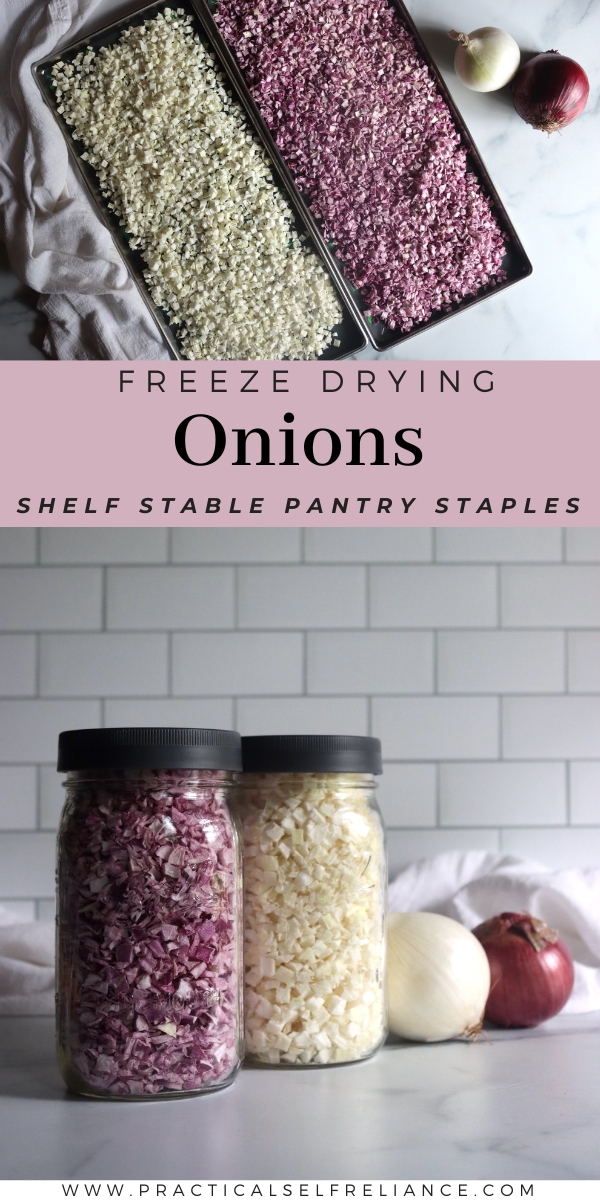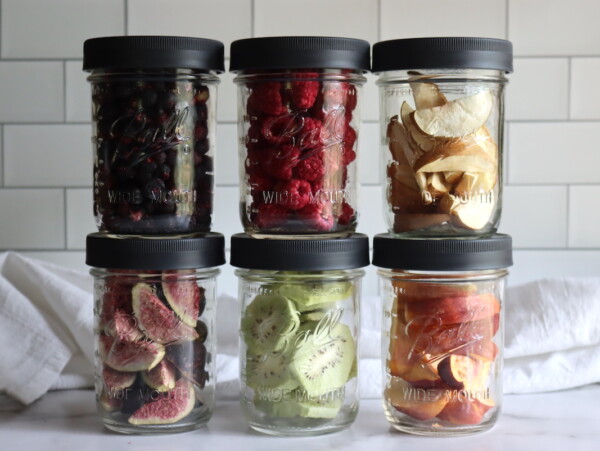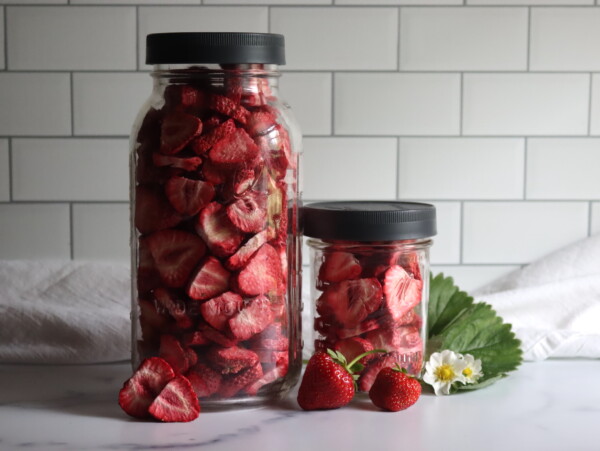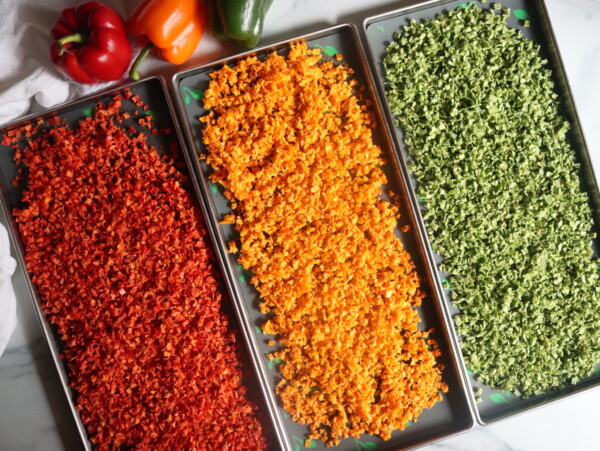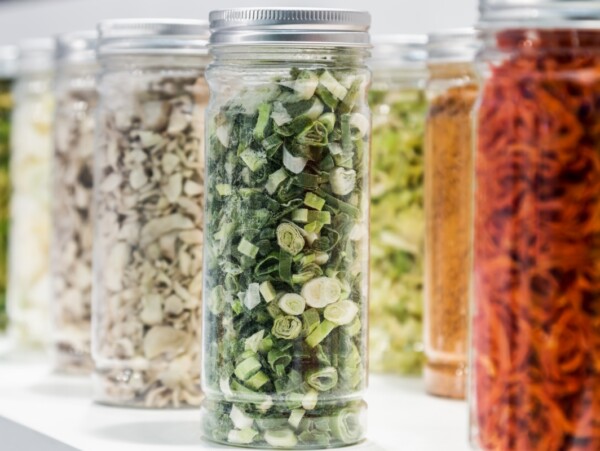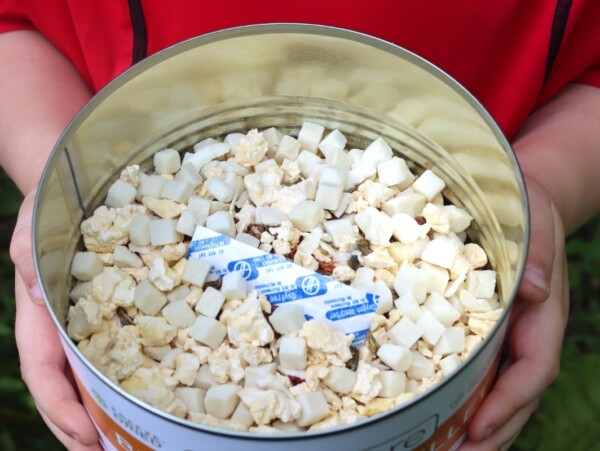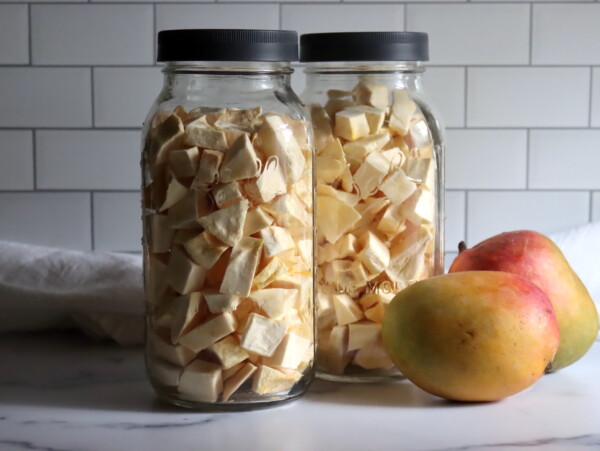Affiliate disclosure: This post may contain affiliate links. Please see our Privacy Policy.
Freeze-dried onions are a must-have pantry staple to keep in the kitchen. Freeze-drying onions are incredibly easy and ensures you’ll always have a supply of onions on hand for adding to soups, stews, savory dinners, and more!
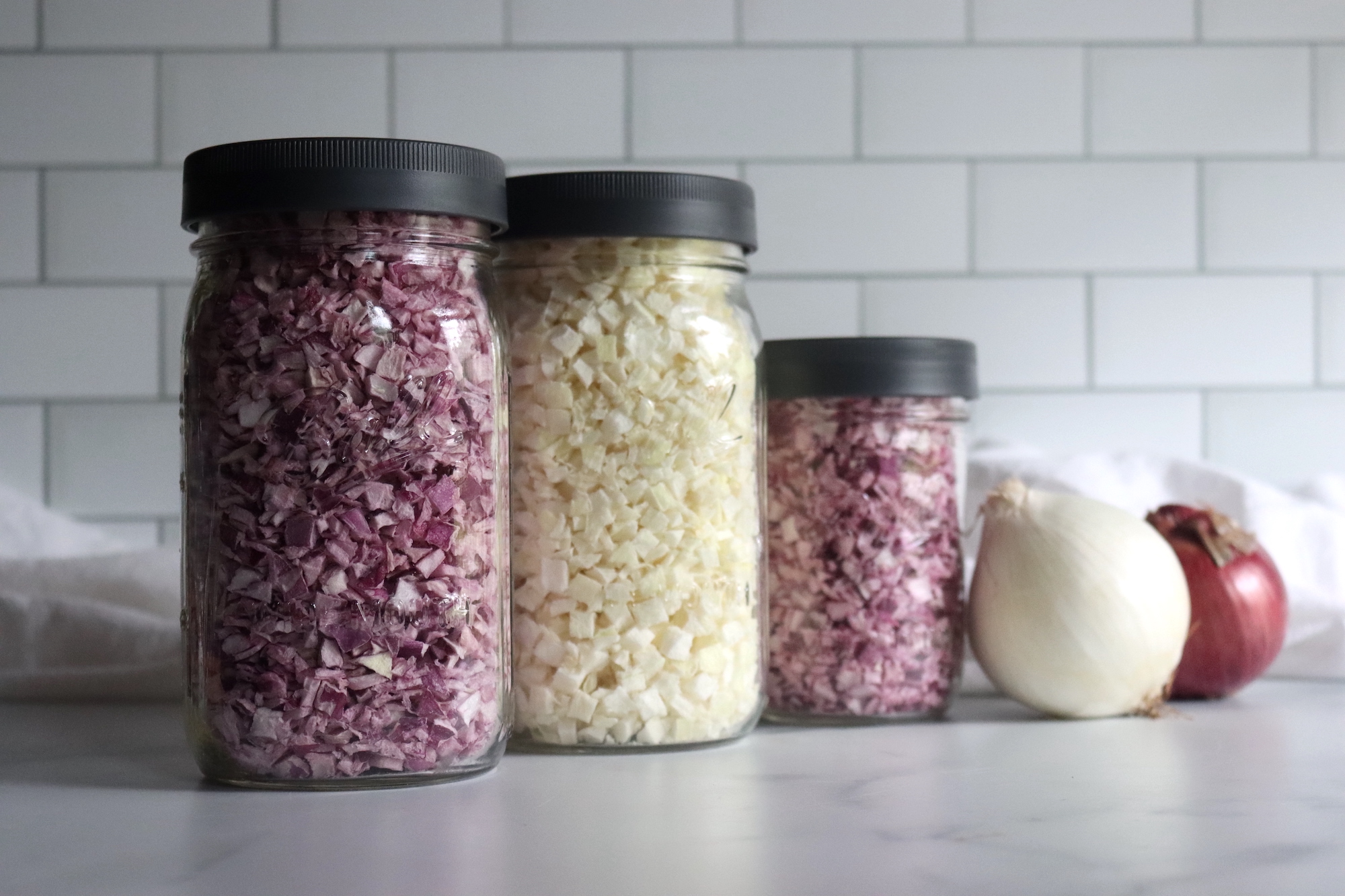
Table of Contents
- What’s the Difference Between Freeze Dried Onions and Dehydrated Onions?
- Best Onions to Freeze Dry
- Freeze Dried Onions Yield
- Supplies Needed
- Preparing Onions for Freeze Drying
- How to Freeze Dry Onions
- Reconstituting Freeze Dried Onions
- How to Store Freeze Dried Onions
- Freeze Dried Onions Recipe
- Freeze Drying Guides
Once you’ve gotten through all the fun freeze-drying projects at the top of your list, freeze-drying pantry staples is a great next step.
While making freeze dried strawberries or freeze dried candy is exciting for kids, freeze-drying those everyday cooking essentials is a great habit to get into as well. You’ll never have to kick yourself for running out of onions again if you always have a jar or bag of freeze-dried ones on hand.
New to freeze-drying foods at home? It’s not hard at all. Just start by reading my beginner’s guide to freeze drying at home and you’ll quickly be on your way to learning how to use a home freeze dryer.
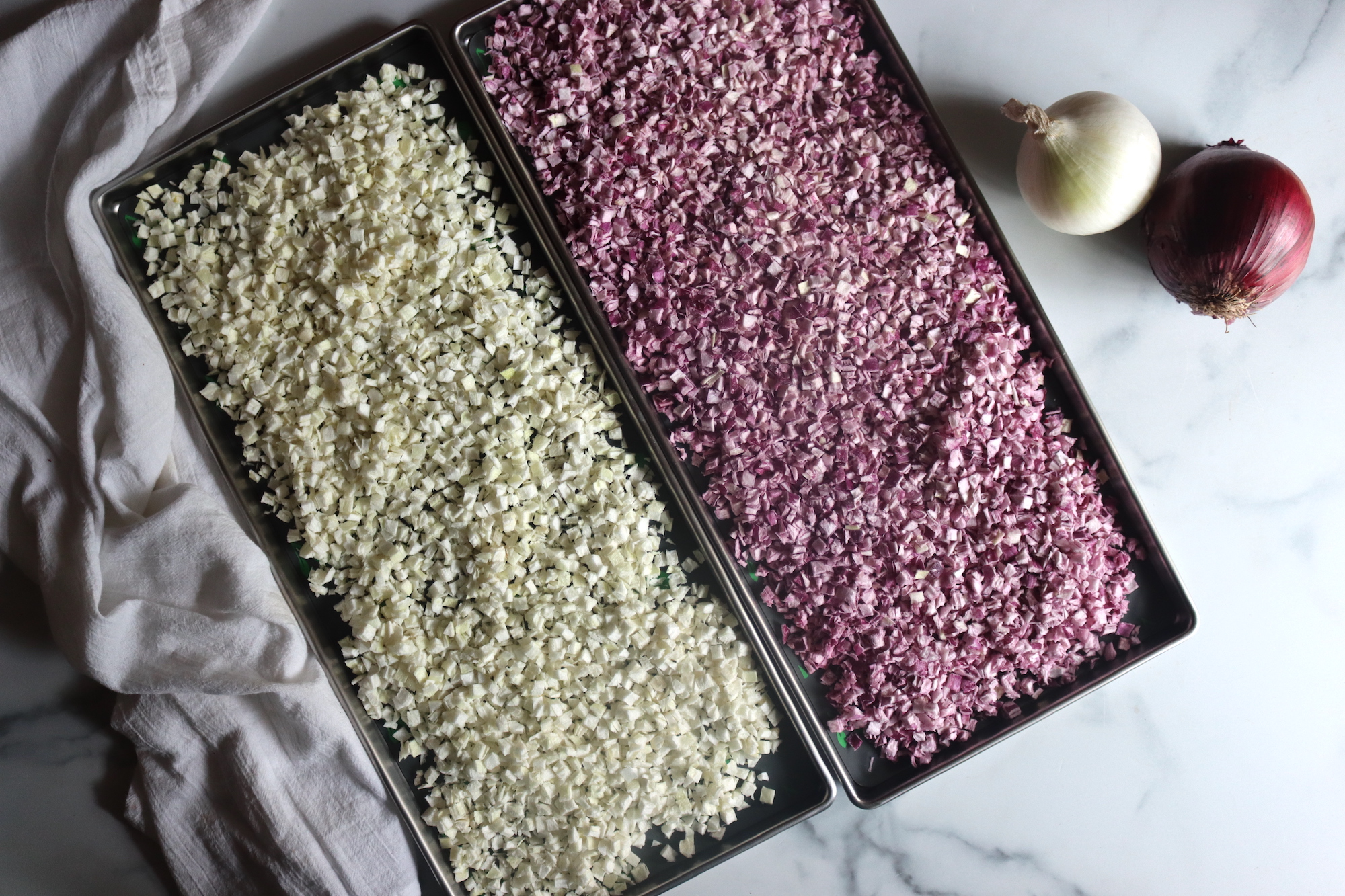
What’s the Difference Between Freeze Dried Onions and Dehydrated Onions?
One of the most notable differences between freeze drying and dehydrating is shelf-life, and the shelf life of freeze dried food is always much longer than dehydrated.
Dehydrated onions, for instance, are best used within a year. They will last longer if stored in ideal locations, but not as long as freeze-dried onions.
This is because freeze-drying removes more water than dehydrating does, leading to longer pantry lives. Freeze-drying also uses a different process, first freezing foods to incredibly low temperatures, then drying them in a vacuum chamber so the frozen water is removed directly into a gaseous state.
By contrast, dehydration uses heat alone to preserve food, causing shrinking and changes to texture. Dehydrated onions shrink up, but freeze-dried ones remain the same size. And even better, once rehydrated, freeze-dried onions plump back up to nearly their original form, making them easy to substitute for fresh onions in many recipes.
Dehydrating onions is perfectly fine if you don’t have a freeze dryer available, but if you ever compare the two side by side, you’ll quickly notice the difference between dehydrated and freeze-dried.
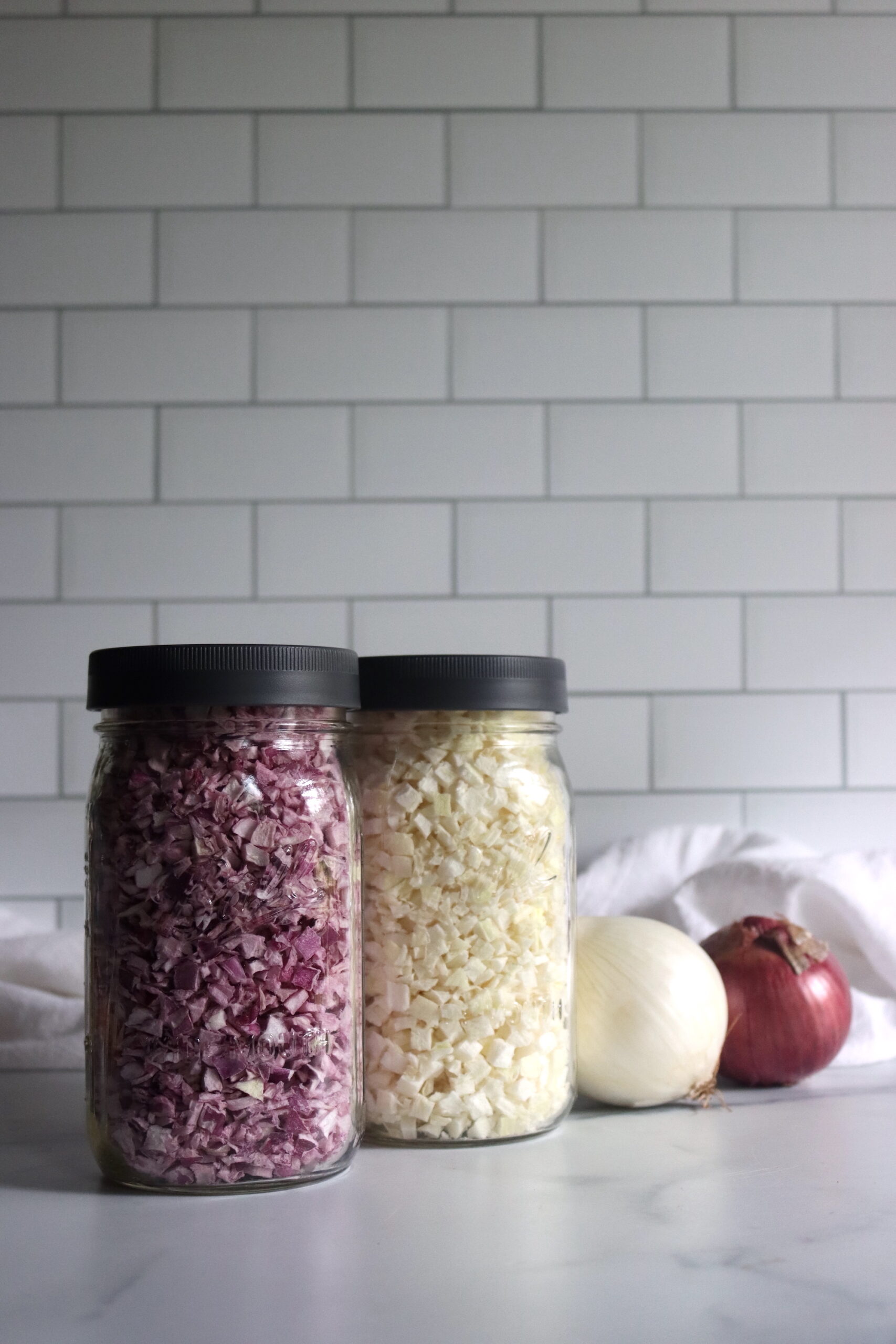
Best Onions to Freeze Dry
The best way to ensure you end up with high-quality freeze-dried onions is to start with good, fresh onions.
There are many types of onions to choose from: yellow, white, red, and sweet — all of which are great for freeze-drying. Yellow onions are very versatile for cooking and great for caramelizing. White onions are a little milder and often used in their raw state. Red onions are great for both, ranging from mild to spicier in flavor.
There are also sweet onions, which possess milder flavors than regular onions. All are fantastic choices for freeze-drying. Just make sure that no matter the variety you choose onions that are firm (not soft) and have dry skin with a papery-like texture. Avoid any onions with soft or brown spots.
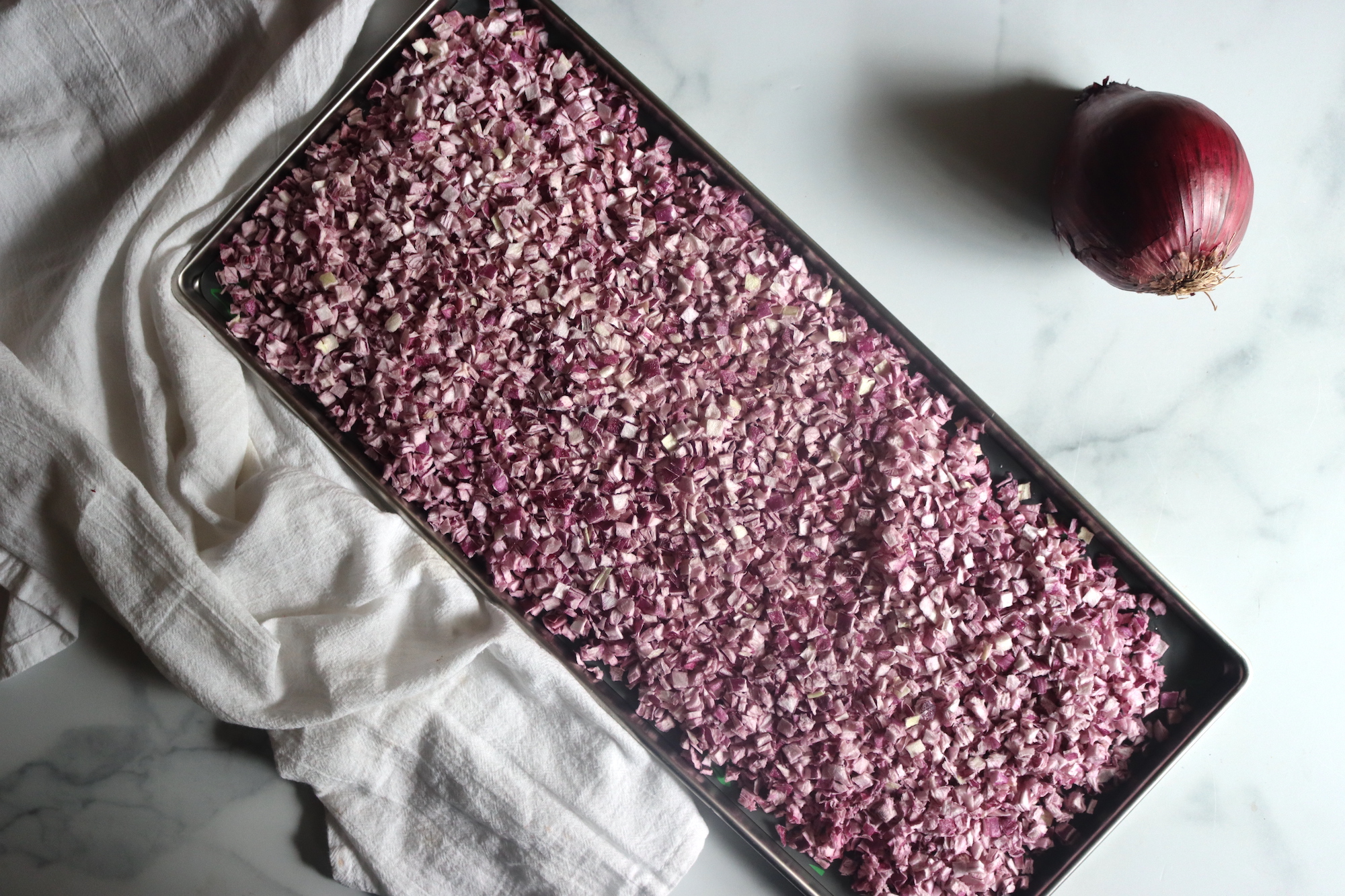
Freeze Dried Onions Yield
A pound of onions is about 2 medium onions, and yields roughly 2 1/2 to 3 cups.
When freeze-dried, onions don’t change in size all that much, so a cup of freshly diced or chopped onions will still equal a cup when freeze-dried.
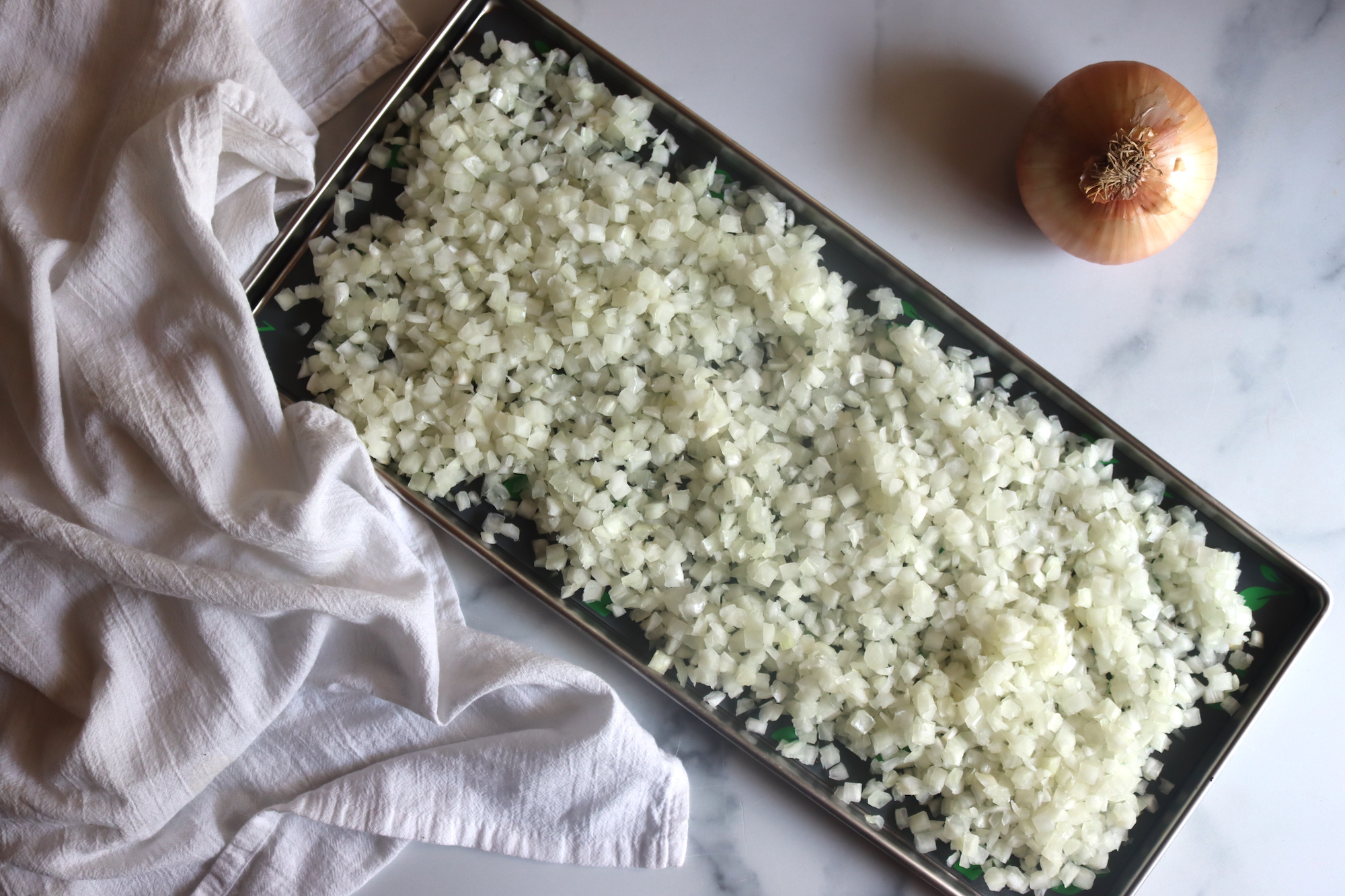
How many onions you can fit in a single batch will depend on the size of your freeze-dryer and its tray dimensions, as well as how heavily you plan to load up the trays.
My freeze-dryer has 5 drying trays and is approved for drying up to 15 to 20 pounds of food. Mathwise, this means I can pack at most 3 to 4 pounds of food per tray. Those would be some heavily packed trays though, and would lead to a longer dry time.
Mainly, I stick to 2 to 3 pounds of food per tray instead. For onions, this means I could fit about 4 to 6 medium onions per tray. Less if they’re big, perhaps more if smaller.
Each individual freeze drying machine will come with its own recommendation for capacity and yield. Here are those amounts based on machine size:
- Small Freeze Dryer: Processes 6 to 10 pounds of food per batch, across 4 trays (434 square inches of drying space).
- Medium Freeze Dryer: Processes 10 to 15 pounds of food per batch, across 5 trays (675 square inches of drying space).
- Large Freeze Dryer: Processes 18 to 27 pounds of food per batch, across 6 trays (1107 square inches of drying space).
- Extra Large Freeze Dryer: Processes 40 to 50 pounds of food per batch, across 7 trays (2257 square inches of drying space).
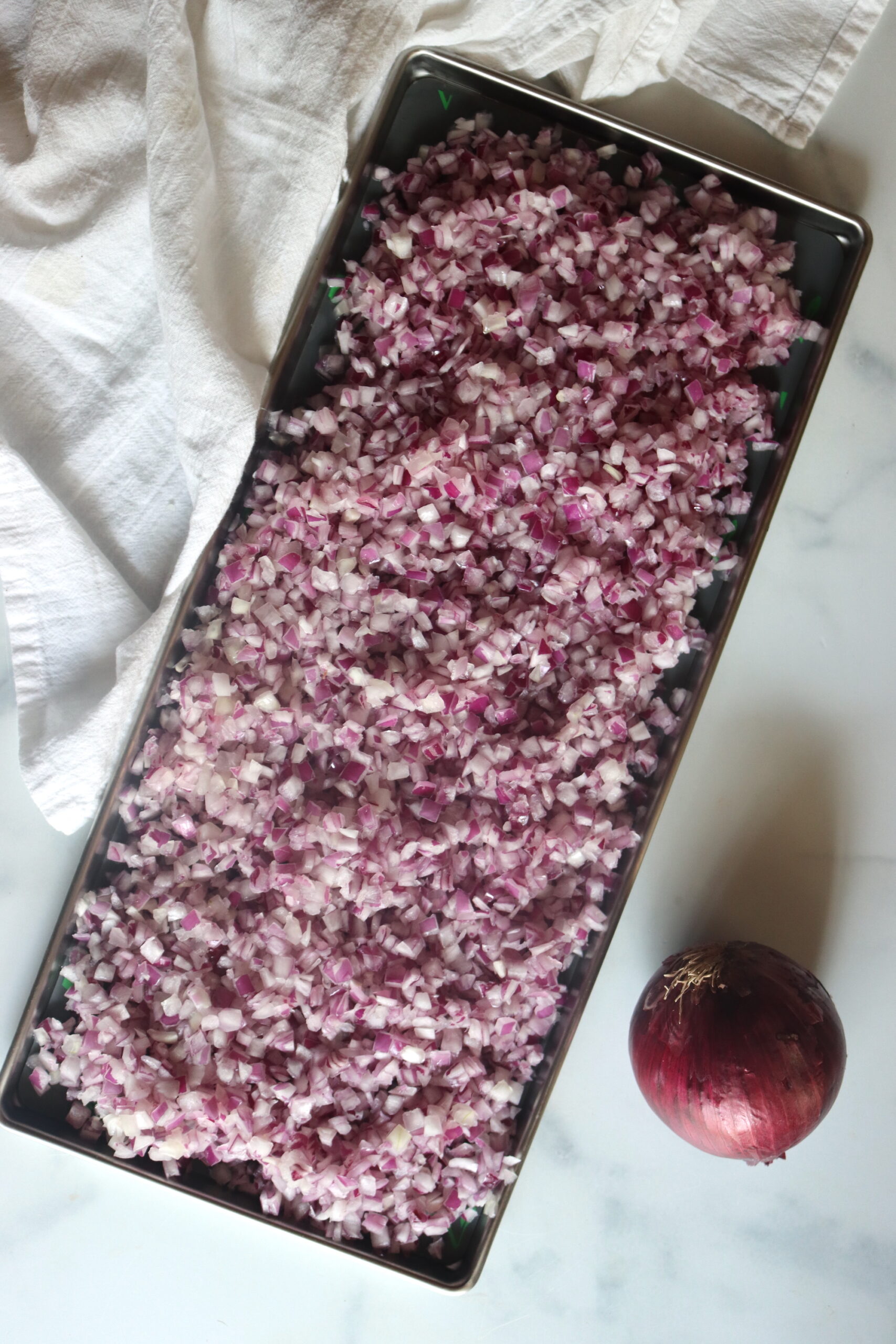
Supplies Needed
To freeze-dry onions with a home freezer dryer, you will need:
- Onions – Once peeled and sliced, these can then be freeze-dried fresh or frozen.
- Home Freeze Dryer – Always pick the size that makes the most sense for your needs, but if between two sizes, consider the larger model. Larger machines cost less to run per pound of food.
- Cutting Board and Knife – For slicing onions into your desired shape — dicing, chopping, or cutting long thin strings are also fine. Uniform-sized slices will dry the best.
- Silicone Tray Liners (or Parchment Paper) – Cleanup will be faster if you line freeze-drying trays first with either parchment paper or silicone liners.
- Colander and Towels – It’s a good idea to wash onions before peeling and slicing, but be sure to dry them well first with a towel to avoid excess water extending the freeze-drying time.
- Mason Jars (Or Airtight Storage Containers) – Oftentimes, we keep our freeze-dried onions in mason jars, knowing that they’ll be used up in a year or two. When storing for extended periods, onions will need to be packed in Mylar bags with oxygen absorbers.
- Vacuum Sealer (Optional) – If you prefer storing foods in mason jars, a vacuum sealer is a great investment. It will help to seal food in mason jars with minimal air.
- Label Tape and a Pen – Labeling all preserved foods is a must, especially in mylar bags as well as mason jars. Dates are particularly important!
Preparing Onions for Freeze Drying
Begin preparing your onions by slicing them. One of the easiest ways to cut an onion is to chop off the root end and pointy tip of the onion, and then cut the onion in half. Next, remove the peel and slice the onion into your desired pieces.
You can chop the onion into larger pieces, leave onions in longer strands or even dice onions. This is a great opportunity to use a mandoline slicer or a food processor. I’ve used my Breville Slice and Dice food processor to quickly and neatly dice fruits and veggies into itty little cubes. My Breville can do 8mm, 12mm, or 16mm pieces (⅓ inch, ½ inch, and ⅔ inch cubes) in a matter of seconds.
Next, you can move directly on to lining your freeze-drying trays and running your freeze dryer, or you can pre-freeze the onions. Pre-freezing onions can shorten the time needed in the freeze dryer.
Onions can be frozen directly on freeze-drying trays if you have a deep freezer or popped into freezer bags and broken up later.
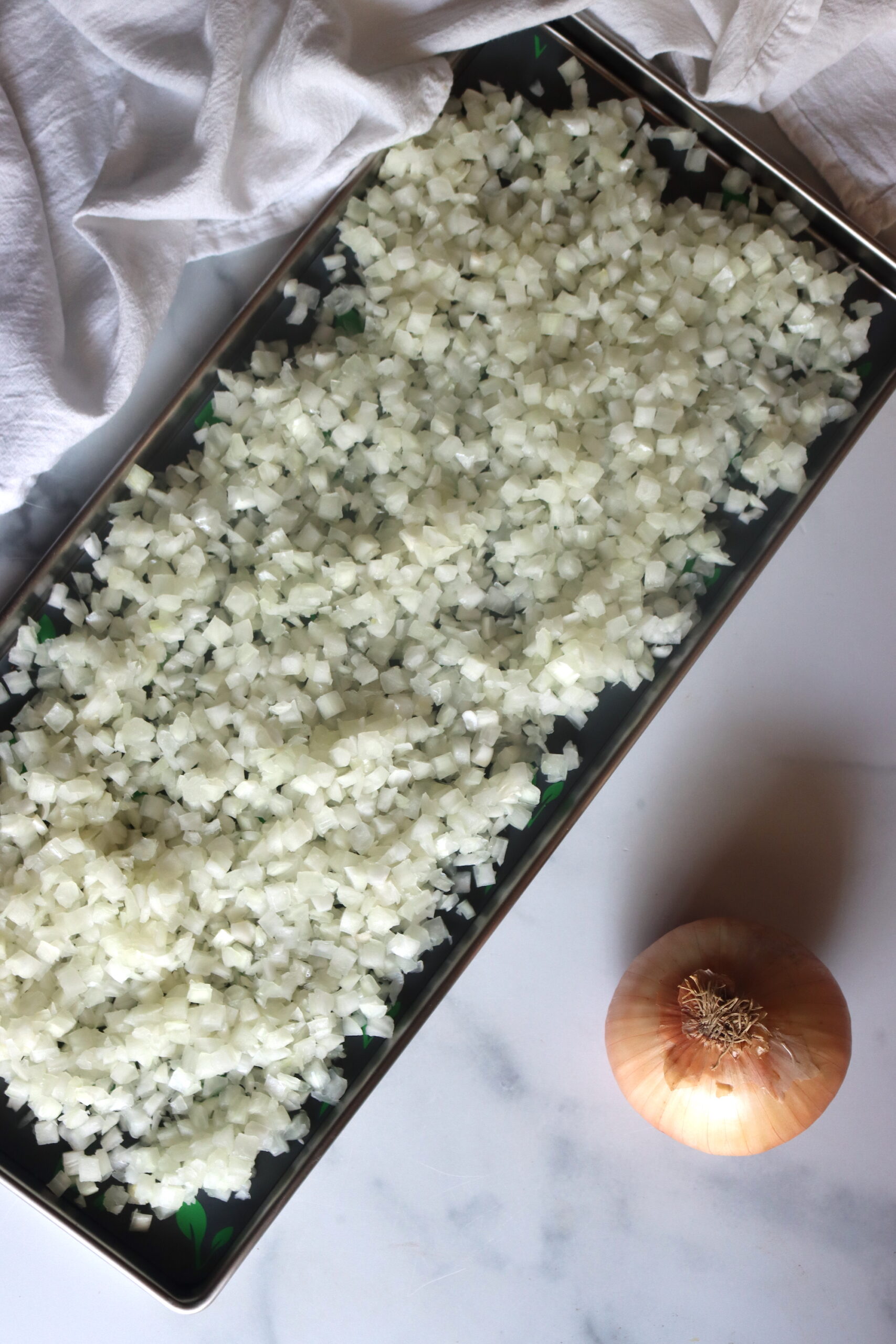
How to Freeze Dry Onions
As soon as you’re ready to run your freeze dryer, turn it on and let it pre-chill for at least 30 minutes.
As the freeze dryer pre-chills, prep your trays. You can line trays with parchment paper or silicone liners if you like — this will help prevent scraping foods off that stick and quicken cleanup.
Spread your onion slices on the freeze-drying trays. Overlapping pieces is fine, but keep in mind that the higher you pile your onions, the longer the freeze-drying time will be. Be sure not to stack foods any higher than the edges of the tray.
When the freeze dryer is prechilled, insert your trays inside and close the door. Press “continue” to let the machine run for a full cycle. Now all you have to do is kick up your feet while the machine works its magic!
Onions can have one of the longer freeze-drying times. Many find that it takes somewhere between 24 and 30 hours. Still, times will vary based on your individual circumstances. Some factors that influence freeze-drying time are:
Pre-Freezing: If vegetables are frozen before entering the freeze dryer it will shorten the time needed in the initial freezing cycle.
Piece Size: Big chunks of onion will take longer to freeze-dry than smaller pieces.
Moisture in the Fruit: Onions with a higher amount of moisture in them will have a longer freeze-drying time than low-moisture varieties.
You will know your onions are fully freeze-dried when they are light, crispy and fully free of moisture. To test and see if onions are fully freeze-dried throughout, grab a large piece and break it in half. It should break and crumble easily between your fingers.
If not fully dry, add some more dry time to your batch and check again in a few hours.
Freeze-dried onions stored in mason jars or another airtight container will maintain their quality for 1 to 2 years. Those that have been sealed in mylar bags along with oxygen absorbers last much longer — up to 30+ years.
Keep in mind that once a jar or bag is opened, the clock begins to tick. Every time a container is opened, moisture is reintroduced to the food through ambient humidity in the air. As such, frequently opened jars might spoil more quickly.
How freeze-dried onions taste will depend solely on the quality of the onions you selected. Freeze-drying won’t change flavors in any way. If you select immature onions or flavorless veggies, they’ll still taste this way after freeze-drying.
Freeze-drying may appear to concentrate flavors due to having all the water content removed, but once a food is rehydrated, it should taste exactly like it did when it was fresh.
For the very best quality freeze-dried onions, be sure to choose the nicest onions you can find, seeking out flavorful onions that have not passed their peak.
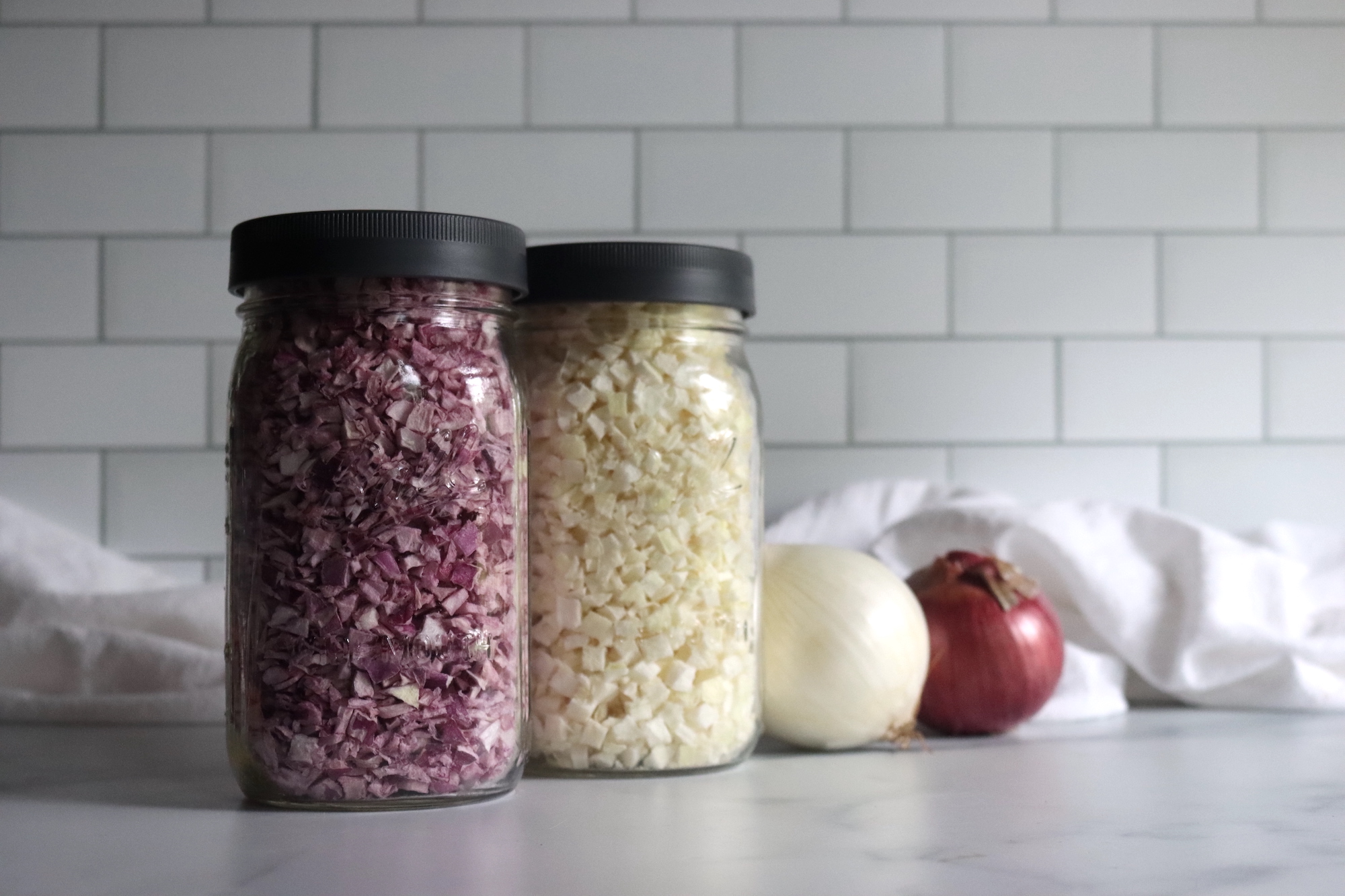
Reconstituting Freeze Dried Onions
Freeze-dried onions don’t need to be rehydrated if using them in soups and stews. Instead, you can toss them straight in and just add a little extra broth. However, if you’d like to use freeze-dried onions in a recipe that requires sauteeing first, you will need to rehydrate them.
To rehydrate freeze-dried onions, place a few in a bowl and cover with water. Let the onions soak up the liquid for 10 to 20 minutes and drain off any excess water. Your onions are now all set to be sauteed, grilled or caramelized — whatever your heart desires.
How to Store Freeze Dried Onions
For everyday, short-term use, storing freeze-dried onions in an airtight container like a mason jar with a tightly fitting lid will be sufficient. This type of storage is ideal for keeping freeze-dried onions handy for tossing into weeknight meals.
When packing freeze-dried onions for long-term storage, a more advanced storage method will be needed. Freeze-dried onions must be sealed in mylar bags with oxygen absorbers.
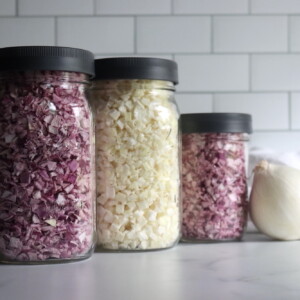
Freeze Dried Onions
Ingredients
- 15 lbs Onions, Fresh or Frozen, for a medium freeze dryer batch
Instructions
- Set your freeze dryer to pre-chill for 30 minutes.
- Next, slice onions into your desired shape. Onions can be chopped, diced or sliced into thin strings. Try to keep slices uniform in size.
- Arrange onion pieces on freeze-drying trays in an even layer. Trays can be lined with parchment paper or silicone liners first if desired.
- When the freeze dryer is pre-chilled, slide the trays inside and close the door.
- Press “continue” to set the machine to run for a full freeze-drying cycle. Drying times will vary based on the thickness of slices, moisture content and how heavily trays are packed. On average, freeze-drying a full batch of onions usually takes somewhere between 40 to 50 hours.
- When the cycle has finished, pull out the trays and check for dryness. Adequately dry onions will be firm, crispy and light. If onions are not fully dry, you will need to lengthen the drying time by a few additional hours.
- Once onions are fully freeze-dried, remove the trays and set the machine to defrost.
- While your freeze dryer is defrosting, go ahead and pack away freeze-dried onions for storage.
- For short-term storage, mason jars with snug-fitting lids will work very well. For long-term storage, onions should be sealed in mylar bags with oxygen absorbers.
Notes
Pre-Freezing
To shorten the freeze-drying time, you can pre-freeze onions before processing them in the freeze dryer. Once sliced, onions can be pre-frozen directly on freeze-drying trays or in freezer bags.Rehydration
To rehydrate onions, place some in a dish and cover with water. Let the veggies rehydrate for 10 to 20 minutes, drain off any unabsorbed liquid, and then proceed with your recipe.Yield
Total yield depends on the size of your freeze dryer. A medium-sized freeze dryer can hold 2 to 3 pounds of diced onions per tray, or 10 to 15 pounds total. One pound of diced onions is about 2 1/2 to 3 cups, and the onions stay the same size after freeze-drying (but weigh less, obviously).Nutrition
Nutrition information is automatically calculated, so should only be used as an approximation.
Freeze Drying Guides
